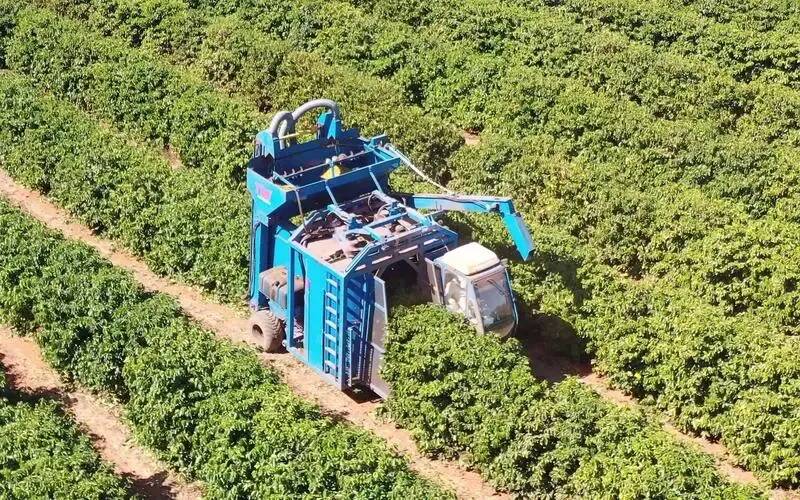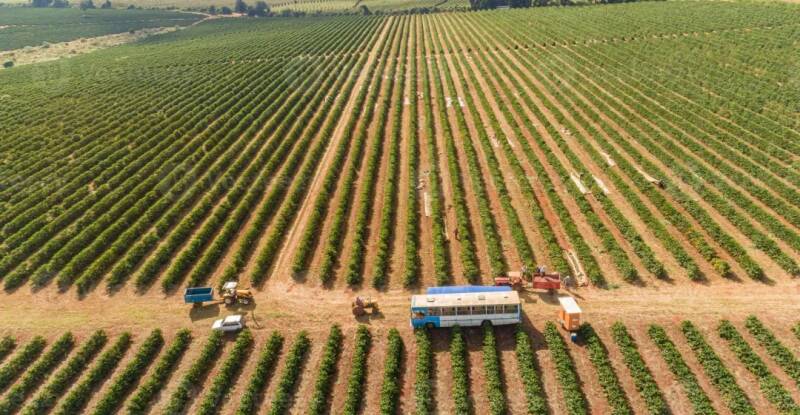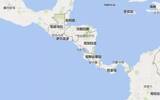Dry weather continues in Brazil! Drought warnings issued in some coffee-producing areas
At present, it is the harvest season for Brazilian coffee, and Brazil has harvested 58 per cent of this year's coffee production, far higher than the 54 per cent average over the past five years, according to data released by consultancy Safras& Mercado.

The acceleration of harvest progress is all due to the fact that the current drier weather conditions are conducive to harvest, but at the same time, high temperature and drought weather may adversely affect coffee production.
From the current actual harvest, coffee production is not ideal, lower than market expectations, and the coffee bean shape is too small. This has also led some local organizations in Brazil to cut their coffee production for the new season. For example, the Marex Group has cut its forecast for Brazilian Arabica coffee production by 2.6 million bags to 44 million bags (60 kg / bag).

In addition, the local coffee agency said that the actual production is expected to be 10-15% less than expected, and it has been reported that the actual production of some coffee farms in the northern state of Esp í rito Santo is less than 30% of market expectations. Due to the small size of coffee beans, it is necessary to use more coffee beans to fill a bag of 60kg.
But recently, in some coffee producing areas in Brazil, the water shortage is more serious. For example, in Alta Mogiana, a sub-region of Sao Paulo state, there has been no rain for more than 100 days, while in Minas Gerais state, the rainfall last week was 1.3mm, only 24% of the historical average, and there had been no rain for three consecutive weeks.
Although a cold snap was reported earlier, the temperature dropped only slightly after the cold snap came, and the temperature remained the same as before after the cold snap ended, and this cold spell did not bring rain.
According to Cooxupe, Brazil's largest coffee cooperative, little rainfall has been recorded since May, water levels in some rivers have fallen, and soil water shortages in some areas need to be paid attention to, all because almost all coffee producing areas have recorded water shortages of more than 20 millimeters less than the historical level in the same period.
At present, the worst is the Hilado producing area in Milashiras, where the water shortage is as high as 44mm and triggered a drought warning signal. In addition to the lack of rainfall, the average temperature in the coffee-growing areas is also 2 ℃ higher than the historical level, and according to the weather forecast, only a small amount of Rain Water is present in Parana, and the weather in the coffee-growing areas will remain dry and dry in the coming weeks.
However, due to the drought, the current production is not as expected, and the price of coffee in Brazil and internationally continues to rise. According to local reports in Brazil, the average spot price of Robusta in Brazil in June was 1214.21 reais per bag (about US $224), the highest level since records began in 2001, and up 20.6% from the average price in May. The average spot price of Arabica coffee is 1349.21 reais per bag (about $249), up 15% from the May average.
Internationally, the futures price of Robusta coffee has risen to 4000 US dollars per ton due to drought in Vietnam. Now, with the news of reduced production in Brazil, the price has soared to 4627 US dollars per ton. As for Arabica coffee futures, in addition to Brazil, the drought weather also affected American countries, especially North America, which reduced Arabica production in the Americas, and the futures price rose to 317.8 cents / pound.
However, the current market concern about the coming La Nina phenomenon is all due to the fact that Brazil has been affected by La Nina phenomenon and suffered severe drought and frost in the past few years, resulting in a more than 20% reduction in Brazilian coffee production. This time the upcoming La Nina phenomenon may reduce coffee production in 2025x26.
Important Notice :
前街咖啡 FrontStreet Coffee has moved to new addredd:
FrontStreet Coffee Address: 315,Donghua East Road,GuangZhou
Tel:020 38364473
- Prev

Costa Rica| Introduction to Western Valley Coffee Estate in Coffee Region
Central America refers to the central part of the American continent south of the United States and north of Colombia. The terrain here is mainly plateaus, mountains and forests. The Pacific side stretches this volcanic belt of more than 1300 kilometers. The climate here is hot and humid. Due to the accumulation of volcanic ash, the soil is fertile. It mainly exports tropical cash crops such as bananas and coffee. in
- Next

Can stainless steel ice cubes be put in coffee? Which cools down better, stainless steel ice grains or homemade ice cubes?
Some time ago, while Qianjie was chatting with friends about ice rush, he found that most coffee shops use regular ice cubes to cool down. Every time he drinks the last few mouthfuls, the iced coffee will always turn to room temperature, and the taste is not as strong as at the beginning, and even has a sense of water. So he quietly sent it to the front street
Related
- Why does hot American coffee taste bitter? Difference in proportional concentration between hot American and ice American
- Is espresso stored overnight in the refrigerator harmful to your body? Is frozen coffee better than freshly ground coffee?
- What parameters and proportions of water temperature should be used to grind and brew fresh coffee beans? Why can't I drink freshly roasted coffee right away?
- Customers have "changed" Manner's new products! Shop assistant: Please don't mess around!
- Remove sockets in customer areas at Starbucks stores?! Netizen: I won't go if I really tear it down
- What is the difference between the taste steps of sun-dried coffee and washed coffee? Why is sun-cured coffee sweeter and washed coffee sour?
- The recipe for salty grapefruit dirty is revealed! Coffee Festival salty grapefruit dirty coffee making materials parameters ratio milk share!
- How about the flavor of Sunlight 74158 at Sidamo Banshaha Mathieu Processing Factory in Ethiopia? 74158 Share the proportion of coffee brewing parameters!
- What effect does Italian American coffee with filter paper have? Will coffee taste better if it is put on filter paper at the bottom of the powder bowl?
- What is the color difference in coffee beans? What are the characteristics of honey processed coffee beans? Why are the anaerobically treated coffee beans uneven in color?

